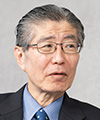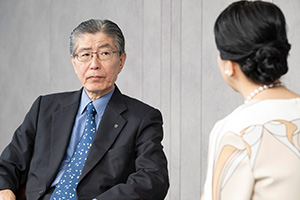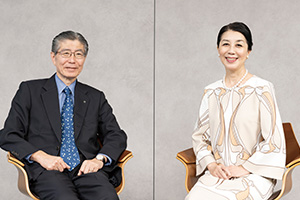 |
|
|
|
|
|
View from the Top Vol. 21, No. 12, pp. 1–5, Dec. 2023. https://doi.org/10.53829/ntr202312tp1
Accumulate Successful Experiences and Cultivate a Can-do Attitude to Becoming a Market-oriented CompanyAbstractNTT Innovative Devices has begun its journey as a manufacturer specialized in photonics-electronics convergence devices. By designing, developing, manufacturing, and selling strategic devices that make up the core infrastructure of the Innovative Optical and Wireless Network (IOWN), the company strives to enable high-speed, large-capacity communications through innovative technologies focused on photonics and contribute to reducing power consumption and building a sustainable society in accordance with the IOWN concept. We asked Hidehiro Tsukano, president & CEO, NTT Innovative Devices, about the company’s business and his mindset as a top executive. Keywords: photonics-electronics convergence device, IOWN, market-oriented mindset Manufacturer specialized in design, development, manufacturing, and sales of photonics-electronics convergence devices—Congratulations on the establishment of NTT Innovative Devices. You serve as the company’s president & CEO as well as the head of NTT IOWN Integrated Innovation Center, right? Since I became the head of NTT IOWN Integrated Innovation Center in 2021, I have realized the power of NTT’s research and development (R&D) and the importance of the Center’s mission through discussions with researchers and reports on research results. At the time of NTT IOWN Integrated Innovation Center was established, NTT was taking concrete steps toward implementation of the Innovative Optical and Wireless Network (IOWN), which was announced two years before. In August 2023, by merging NTT Electronics, which was an existing operating company, we established a new company, NTT Innovative Devices. As the head of the new company, I have a renewed sense of the heavy responsibility of being in a position to actualize IOWN through the development and commercialization of photonics-electronics convergence devices that form the core of IOWN. To provide such devices, we are striving to organize related technologies and processes, streamline the process pipeline, and prepare the environment to manufacture the devices within two years. In terms of speed, we hope to be able to reap the results of those actions as a business in our third year. In the NTT Group, which employs 330,000 people and generates annual sales of 13 trillion yen, we are in the very unique position of being a device company with 1100 employees and consolidated annual sales of 44.3 billion yen and having a manufacturing department.
—Could you tell us about the specific business and vision of NTT Innovative Devices? We are a manufacturer specialized in photonics-electronics convergence devices with a full scope of functions, such as design, development, manufacturing, and sales. Our predecessor, NTT Electronics, provided its customers with core components for medium- and long-haul optical transmission, such as coherent digital signal processors and optical transceivers, and focused on telecommunications carriers as its main end customer. Such products had been manufactured by using technology for fabricating optical devices on silicon substrates using microfabrication technology for large-scale integration circuits (LSIs) and technology for integrating these optical devices and digital coherent devices for medium- and long-haul optical transmission in a single package. After becoming NTT Innovative Devices, we want to expand our products into the field of computing—which we consider to be a new market. For the traditional field of medium- to long-haul optical transmission, we will continue to evolve our products for even-higher-capacity and longer-haul optical transmission. We are also accelerating the development of products for low-power and short-haul optical transmission. We plan to unveil these products at Expo 2025 Osaka, Kansai, Japan. Our medium-term goal is to enable photonics-electronics convergence devices to be mounted from on the edge of chassis to the edge of boards for high-capacity and short-haul optical transmission such as in clusters and between servers and storage in datacenters. Our long-term goal is to develop chiplets by reducing the size and thickness of photonics-electronics convergence devices and by mounting LSIs and optical devices on the same substrate. We are mounting such chiplets from the edge of system boards to the edge of a semiconductor chip on boards. By embedding such chiplets on the edge of silicon dies inside semiconductor packages, we aim to create a market in which chiplets are built into logic LSI packages such as various processing units called xPUs. We hope that in the future, optical chiplets will be used in various areas so that the world’s estimated 9.5 billion people in 2050 will be able to enjoy the benefits of the power of photonics—including low power consumption, low latency, and high-transmission-capacity communications.
Actualizing strategic devices for building the core infrastructure of IOWN—You have a clear vision. What exactly is the mission of your company? Could you tell me financial goals? Our mission is to actualize strategic devices in building the core infrastructure of IOWN and reduce power consumption, which is a significant goal of the NTT Group for contributing to society. The deployment target of IOWN covers a vast area and consists of four layers. The first layer is composed of semiconductor devices, and the second layer is composed of elements of the core infrastructure that enables the IOWN world to be created using the first-layer devices. This layer is equivalent to the current “box”-type server-oriented architecture consisting of network interface cards and various computing resources. The third layer is network applications, and the top (fourth) layer is composed of solution services and business for providing added value to external customers. Our primary goal is to increase the value of the fourth layer. To that end, it is important to accelerate the development of devices for low-power and short-haul optical transmission while pursuing high-capacity transmission by increasing performance of the first-layer devices. In terms of financial goals, we are aiming for annual sales of 100 billion yen. Since the consolidated annual sales of NTT Electronics were approximately 40 billion yen, our first hurdle will be doubling that amount. How quickly we can achieve that goal depends on how quickly we can accelerate product development, on which we are working hard. —Annual sales of 100 billion yen are eagerly anticipated. We’d like to hear about your specific strategies for achieving the goal. Ultra-small and thin chiplets mean that photonics-electronics convergence devices are structurally closer to semiconductors than to modules. We can therefore say that our direct customers are the manufacturers who use these semiconductors. In addition to Japan, the main sales region is North America, followed by Europe, where we were able to tap into the French market. We also have access to Asia. To succeed in this market, we first must enable photonics-electronics convergence chiplets to be introduced in a wider range of computing areas; however, this will not be possible without first and foremost a large volume of devices. Therefore, it is necessary to establish mass-production technology to improve the ability to supply a large volume of devices and reduce costs. Regarding our position in this market, we are at the leading edge compared with other players in terms of technology since our products are based on the photonics-related technologies that NTT R&D has developed and accumulated over the past 20 to 30 years. However, even though we have cutting-edge technology and excellent knowledge of cutting-edge products, we are clearly inferior to our competitors in terms of our business approach, including our sales capabilities. This situation is somewhat understandable because we are a technology- and product-oriented company where products are developed through technology transfer of research results. In a nutshell, I want to rethink the business of NTT Innovative Devices from a “business” perspective and develop it with a market-oriented mindset. I’m now thoroughly reviewing all operations from a business perspective while drawing on my 26 years of experience at Fujitsu and giving direct instructions to each person in charge. When the technologies and ideas created in research laboratories entered the development phase and were provided to the group’s operating companies, if they were viewed from a business perspective as a service or product, they often needed to be adjusted to meet market needs or reduce costs. However, they could not be modified and brought to market because the operating companies did not have a manufacturing department. Since NTT Innovative Devices has a manufacturing department, we believe that we can considerably improve the business practices that have been adopted since the days of NTT Electronics by establishing the process of tailoring products backcast from market needs through discussions at each point from a business perspective.
Review traditional business processes from a market-oriented perspective—It seems that the presence of NTT Innovative Devices will change drastically from what it has been. You mentioned earlier that the company will be reorganized and streamlined within two years. What is the meaning of the time frame of this reorganization? I want to embed ideas based on the knowledge and experience I have gained during my previous job at Fujitsu and as the head of NTT IOWN Integrated Innovation Center into NTT Innovative Devices as quickly and deeply as possible. I wanted to change what we could in one year so that we could start reaping the benefits in the second year. However, in the situation in which I alone will be trying to embed my knowledge and experience into the company culture, I am not sure how quickly I can change the product-oriented mindset to a market-oriented mindset. It takes a lot of energy to change what has become a custom; thus, I sometimes wonder if I’m tired of embedding my ideas after a year. We humans have a tendency to give up on something that is too difficult, so I fear that I might. Therefore, I have no choice but to accomplish the reorganization in the short term. That is, I want to achieve structural reforms in the two-year range and see results in the third year. This challenge can be considered a kind of self-evaluation. I started communicating my ideas after August 1, 2023, when the company was established, and by the end of September, 95% of the company had become what I had envisioned. That was scarily fast. I believe that it is important to be able to feel that the position of NTT Innovative Devices has changed and to accumulate successful experiences that show that we can do anything if we try. Naturally, not everything goes smoothly, and sometimes things don’t go as planned. We don’t want to spend too much time trying to escape from such a situation, but I think we have no choice but to persevere. In any case, I want to work hard to push for change. I’m driven to work in this manner because I feel that the moment I stop, I will degenerate. I want to pursue what I like at my own speed, and I don’t want to be left behind by the world. —Finally, would you tell us what it is to be a top executive and what type of a top executive you would like to be? And please give us your message to NTT researchers, the company’s employees, customers, and partners. To put it simply, no one is behind the top executive. The president takes responsibility for anything that happens in business, be it good or bad. In a sense, the top executive is a solitary entity. If the top executive does not say to the employees, “Let’s change, let’s do this,” those who think it’s fine to continue as is will not change. The size of the organization and its social responsibilities may vary from company to company, but from the perspective of the president’s job, I believe that they are essentially the same entity. In other words, the person at the top must make decisions and take responsibility for such decisions. And choices and decisions should be made as quickly as possible. I believe that NTT Innovative Devices should not rely on the safety net that is being a member of the NTT Group. I want to build a mindset that allows NTT Innovative Devices to operate as an independent device company. NTT has published a roadmap of photonics-electronics convergence devices to 2032, when the fifth-generation products of such devices will be released. The announcement of the roadmap demonstrates NTT’s confidence, and companies have come together to hear about materials, services, etc. We have also been able to start creating an industrial ecosystem and see the reactions of our competitors in a manner that has allowed us to read the trends in the market. As I mentioned at the beginning, we plan to announce the third generation of NTT Innovative Devices products in 2025. NTT R&D departments deal with wide-ranging fields and has a discerning eye in many different areas. We have streamlined the process pipeline, which enabled us to shorten the time to introduce superior technologies and products to society by about three or four years per generation. We hope that our customers and partners will confirm our clearly stated goals in the roadmap and bring their ideas of how they would like to engage with our products and services. Neither the value chain nor the supply chain can be established by one company alone. We want to make the chain—which used to be thin and long like a spider’s thread—into something thicker, stronger, and more flexible. Interviewee profileCareer highlightsHidehiro Tsukano joined Fujitsu Limited in 1981, where he worked in the purchasing department, focusing on semiconductors. In his career at Fujitsu, he became head of Corporate Planning and Business Strategy Office in 2009 and representative director, senior executive vice president, and chief financial officer in 2017. He has also served as chief human officer and chief strategy officer, in charge of all departments as assistant to the president. In 2019, he became vice chairman of the company. After working as an advisor to NTT Advanced Technology Corporation and senior advisor in the Research and Development Planning Department of NTT in 2020, he has been senior vice president, head of NTT IOWN Integrated Innovation Center since 2021 and president & CEO of NTT Innovative Devices Corporation since August 2023. |




